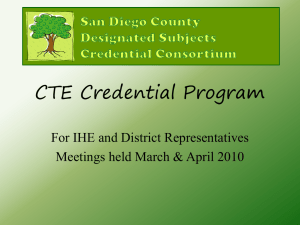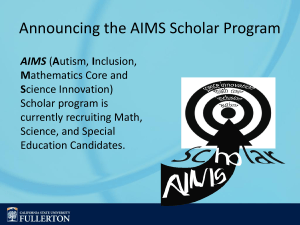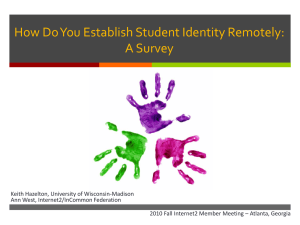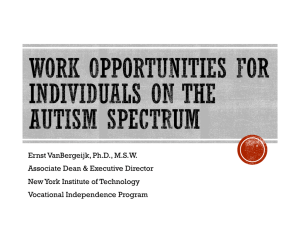How Principals Learn to Lead
advertisement
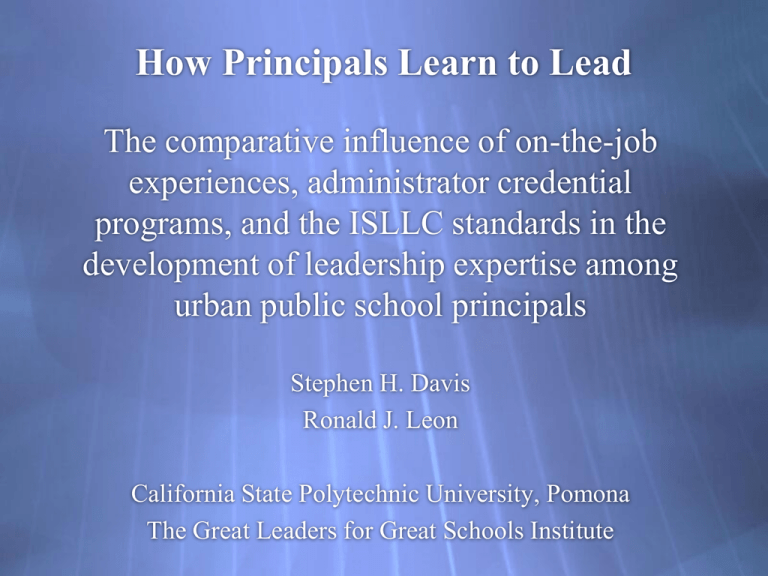
How Principals Learn to Lead The comparative influence of on-the-job experiences, administrator credential programs, and the ISLLC standards in the development of leadership expertise among urban public school principals Stephen H. Davis Ronald J. Leon California State Polytechnic University, Pomona The Great Leaders for Great Schools Institute Purposes of the Study Focus: Urban Public School Principals 1. How do urban principals develop leadership expertise? 2. How important (comparatively) are on-the-job experiences and EADM credential programs in the development of leadership expertise? 3. How do the 1996 ISLLC standards influence the development of leadership expertise? Rationale 1. Growing body of criticism 2. Critical need for competent principals 3. Leadership reform agenda 4. Need to understand the venues where leadership is developed 5. Potency of national EADM standards Conceptual Framework • Experiential Learning (Rogers) • Situated Cognition (Lave) • Transformative Learning (Mezirow) • Adult Learning: Androgogy (Knowles) Methods Research Design • Ex-post facto, exploratory • Online survey & follow-up interviews • Quantitative & qualitative analyses Sample: Survey • 200 urban k-12 principals (25 largest metro districts) • Stratified random sample (proportional to E, MS, HS) Sample: Interviews • 20 randomly selected survey participants • 16 female, 4 male; 14 elementary, 6 secondary Responses • 101 (52%) • Elem (64%), Middle (13%), HS (23%) Survey Instrumentation 1. 41 learning tasks (1996 ISLLC based) 2. 12 demographic questions 3. Subgroups • • • Years of experience (1-5; 6+) Gender Type of school (elementary; middle; HS) 4. Response options • • On-the-job experiences vs credential program Importance of each learning task DATA ANALYSES Factor 1: CREDENTIAL PROGRAMS VS ON THE JOB Factor 2: TASK IMPORTANCE DESCRIPTIVE (frequencies, totals, means---whole group & sub groups) WHOLE GROUP 1. Principal Component Factor Analysis (data reduction, thematic clustering) 2. Pearson r Correlation (CP vs OTJ--distinctiveness) 3. One Way ANOVA (mean differences) 4. Significance of the Difference Between Two Independent Proportions (individual task proportionality) WITHIN GROUP 1. Chi Square (goodness of fit)—single task variable discrepancy 2. One Way ANOVA (CP vs OTJ) Interview Protocol Seven prompts 1. Your most important on-the-job experiences 2. Missing experiences early on 3. Most important experiences for first year principals 4. Veteran principals renewal 5. Types of district office support 6. Most helpful credential program activities 7. Suggestions for credential program improvement Interview Analysis 1. Search for key themes and patterns (e.g., sensitizing concepts, recurring regularities-Patton) 2. Illuminate both the emotional and conceptual 3. Three organizing categories (Yukl) • • • Relations Tasks Change Survey Results Demographics Years of Experience More than 5 (52%) Less than 6 (48%) Age Group 25-45 (13%) Over 45 (87%) Gender Male (25%) Female (75%) School Type Elementary (68%) Secondary (32%) Survey Results Demographics, continued Age Groups 25-35 (4.9%) 36-45 (13.7%) 46-55 (34.3%) 55+ (46.1%) Type of Credential Program Public university (52.9%) Private university (30.4%) District sponsored (2.9%) Other (13.8%) Survey Results Demographics, continued Year of Credential Issue Pre-ISSLC (62.1%) Post-ISSLC (37.9%) Since NCLB (8.4%) School Free & Reduced Lunch Mean (69.8%) Median (76.0%) School Enrollment 2000+ (6.9% 1000-2000 (11.9%) Under 1000 (80.2%) CP vs OTJ: Correlations TASKS WITH R VALUES OF .50 OR GREATER (highly correlated) Note: Low CP vs OTJ distinction (.632) Task 35: Code of ethics (.608) Task 17: Formative evaluation (.602) Task 38: School governance (models) (.582) Task 29: Collective bargaining (.571) Task 37: Professional dispositions (.531) Task 26: Facilities and grounds (.520) Task 34: Teacher collaboration (.517) Task 40: Political advocacy (for schools) (.506) Task 21: Professional growth (for teachers) (.500) Task 13: Motivational strategies CP vs OTJ: Correlations TASKS WITH VERY LOW R VALUES (low correlation) Note: High CP vs OTJ distinction (.113) Task 1: Strategic plan (.113) Task 2: Using data (.152) Task 5: Dealing with competing interests (.165) Task 4: Communications (.186) Task 3: Self-reflection (.192) Task 6: Facilitate group consensus FACTOR ANALYSIS (data reduction and clustering) ON THE JOB EXPERIENCES Cluster 1: Teaching and Learning (.792) Task 15: Coaching and supporting (.760) Task 34: Teacher collaboration (.722) Task 23: School improvement (org. beh.) (.650) Task 21: Professional growth (teachers) (.628) Task 17: Formative evaluation (.592) Task 39: Equity and diversity FACTOR ANALYSIS ON THE JOB EXPERIENCE, continued Cluster 2: Operations and Resources (.734) Task 27: Legal requirements (.715) Task 25: Fiscal resources (.664) Task 24: Systems and safety (.644) Task 28: Administrative technologies (.641) Task 12: Program development FACTOR ANALYSIS ON THE JOB EXPERIENCES, continued Cluster 3: Relations (.716) Self reflection (.689) Communications (.584) Community trends, issues, needs (.524) Community relations FACTOR ANALYSIS CREDENTIAL PROGRAMS Cluster 1: Teaching and Learning (.752) Task 17: Formative evaluation (.723) Task 13: Motivational strategies (.701) Task 34: Teacher collaboration (.626) Task 15: Coaching and supporting (.592) Task 21: Professional growth (teachers) FACTOR ANALYSIS CREDENTIAL PROGRAMS Cluster 2: Operations and Resources (.756) Task 25: Fiscal resources (.730) Task 29: Collective bargaining (.670) Task 26: School facilities (.633) Task 27: Legal requirements (.616) Task 33: Media relationships (.615) Task 31: Community resources FACTOR ANALYSIS CREDENTIAL PROGRAMS, continued Cluster 3: Decision-making (.676) Task 5: Dealing with competing interests (.748) Task 6: Group consensus (.560) Task 11: Participatory decision-making Key Findings 1. OTJ experiences are significantly more important than credential programs for 37 of 41 tasks (4.38 vs 3.66) 2. Subgroups that were significantly more likely to attribute importance to OTJ experiences: More Experienced vs. Less Experienced (93% vs. 81%) Females vs. Males (93% vs. 73%) Elementary vs. Secondary (93% vs. 66%) How Important Are the 41 ISLLC Tasks? OVERALL 32 (78%) tasks rated .80 or higher TOP 5 1. 2. 3. 4. 5. Establishing a shared vision Coaching and supporting teachers Facilitating professional collaborations Using data to advance teaching & learning Establishing an instructionally focused school culture How Important Are the 41 ISLLC Tasks? BOTTOM 5 1. 2. 3. 4. 5. Using symbolic leadership Working with collective bargaining agreements Establishing positive media relations Advocating for schools via political arenas Currency with state, national, global trends Where Does Task Learning Occur? On-the-Job Experiences: Highest Rated Tasks 1. Establishing an instructionally focused school culture 2. Negotiating with people who have competing interests 3. (tie) a) Developing a long term strategic plan b) Using data to advance teaching and learning 4. Coaching and supporting teachers Where Does Task Learning Occur? Credential Programs: Highest Rated Tasks 1. 2. 3. 4. 5. Using a code of ethics to guide leadership behavior Promoting principles of equity and diversity Coaching and supporting teachers Evaluating teacher performance Establishing an instructionally focused school culture Interview Results Most Important On-the-Job Experiences 1. 2. 3. 4. 5. Building positive relationships Managing the school budget Supervision & evaluation Learning about the school culture Learning how to deal with difficult staff members How Can Districts Best Support Leadership Development? 1. 2. 3. 4. 5. 6. Trainings, seminars, institutes Conference attendance Facilitate/support PLCs Coaching support Regular and focused principals’ meetings Aligning principal evaluation with professional development How Can Credential Programs Best Promote Leadership Development? 1. 2. 3. 4. 5. 6. 7. Observing and shadowing principals Fieldwork (structured, problem-based) Hands-on budgeting and operations management Activities that combine “research and reality” Learning in a cohort setting Team-based learning activities On-the-job projects that involve interacting with the district office 8. Community engagement (learning activities) Important Conclusions • • • • • Credential programs matter a lot (this is reassuring) On-the-job experiences matter more (this is not surprising) 1996 ISLLC Standards remain vital and important to the field (this is reaffirming) OTJ experiences matter most to female and elementary principals (this is curious) Learning tasks linked to instruction matter most (this is good) Important Conclusions • • • • • Politics, policy, media, symbolic--matter least (this is understandable, but concerning) Budget, budget, budget! (this is essential and concerning) Learning to lead requires interactive, relational, and problem-based activities (this is essential) Link credential programs and theories of adult learning (this is essential) Districts have great potential to develop principal leadership (this is essential)
